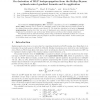Free Online Productivity Tools
i2Speak
i2Symbol
i2OCR
iTex2Img
iWeb2Print
iWeb2Shot
i2Type
iPdf2Split
iPdf2Merge
i2Bopomofo
i2Arabic
i2Style
i2Image
i2PDF
iLatex2Rtf
Sci2ools
IJCNN
2000
IEEE
2000
IEEE
On Derivation of MLP Backpropagation from the Kelley-Bryson Optimal-Control Gradient Formula and Its Application
The well-known backpropagation (BP) derivative computation process for multilayer perceptrons (MLP) learning can be viewed as a simplified version of the Kelley-Bryson gradient formula in the classical discrete-time optimal control theory [1]. We detail the derivation in the spirit of dynamic programming, showing how they can serve to implement more elaborate learning whereby teacher signals can be presented to any nodes at any hidden layers, as well as at the terminal output layer. We illustrate such an elaborate training scheme using a small-scale industrial problem as a concrete example, in which some hidden nodes are taught to produce specified target values. In this context, part of the hidden layer is no longer “hidden.”
Discrete-time Optimal Control | Hidden Layer | IJCNN 2000 | Kelley-Bryson Gradient Formula | Neural Networks |
| Added | 31 Jul 2010 |
| Updated | 31 Jul 2010 |
| Type | Conference |
| Year | 2000 |
| Where | IJCNN |
| Authors | Eiji Mizutani, Stuart E. Dreyfus, Kenichi Nishio |
Comments (0)

